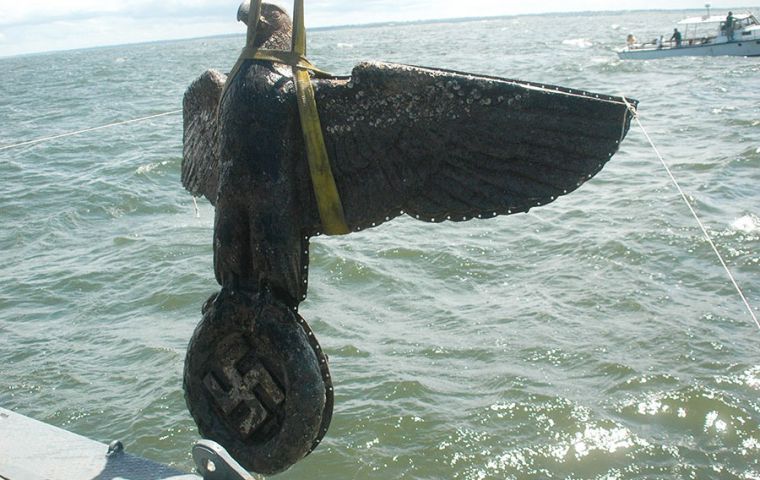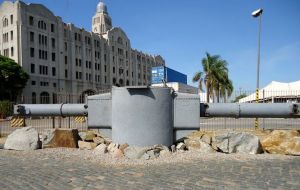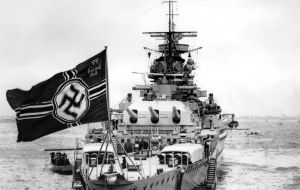MercoPress. South Atlantic News Agency
Battleship Graf Spee Nazi eagle must be sold, orders Uruguayan court
 The eagle was briefly displayed in a Montevideo hotel after being recovered, before being taken to storage
The eagle was briefly displayed in a Montevideo hotel after being recovered, before being taken to storage  The telemeter was recovered first, in 2004, a huge piece weighing 27 tons, which at the time was state of the art technology for firing accurately heavy guns
The telemeter was recovered first, in 2004, a huge piece weighing 27 tons, which at the time was state of the art technology for firing accurately heavy guns The Graf Spee was scuttled in December 1939 off the Uruguayan coast, after battling against HMS Ajax, HMS Achilles and HMS Exeter.
The Graf Spee was scuttled in December 1939 off the Uruguayan coast, after battling against HMS Ajax, HMS Achilles and HMS Exeter. Uruguay's government must sell a huge, bronze Nazi eagle, and gun ranging telemeter, salvaged from a sunken World War II era Nazi Germany warship, a court ruled on Friday. The nearly 350 kilo eagle with a swastika held in its claws was part of the stern of the German “pocket battleship” Admiral Graf Spee that was sunk off the coast of Montevideo in December 1939, that is almost eighty years ago.
The Third Reich symbol has been the object of controversy for years over German claims of ownership and objections against the piece being displayed in public or sold.
The Uruguay court ruled the eagle that has been stored in a wooden box in a naval warehouse must be auctioned off within 90-days and the proceeds divided 50/50 between the investors of the project who recovered the relic from the bottom of the River Plate, and the Uruguayan government, ministry of Defense and Coast Guard.
The Uruguayan government can still appeal the ruling of the lower court, but defense attorney Rodriguez Arralde said it did not make sense, since it's a win-win situation, both sides are entitled to 50%.
Furthermore, a year ago the Uruguayan defense minister called on all political parties with congressional representation to decide what to do with the eagle, if the time was right for its sale or to definitively store it away.
According to Montevideo media reports the sale of the Graf Spee eagle could fetch several million dollars, since it is the only one ever recovered from the Nazi Germany fleet, but the issue has been most controversial. For one Germany has previously said it was against the commercialization of any symbols of the Nazi regime, but would support the presentation of the eagle within a proper historical context such as a museum.
Private investors with the backing of the Uruguay government undertook salvage work in 2004 to remove valuable pieces from the wreck sunk in the muddy bottom of the River Plate.
In 2006, divers hired by the Etchegaray family behind the project uncovered the eagle. The eagle was briefly displayed in a Montevideo hotel after being recovered, before being taken to storage after Germany protested against exhibiting “Nazi paraphernalia.”
The telemeter was recovered first, in 2004, a huge piece weighing 27 tons, which at the time was state of the art technology for firing accurately heavy guns, despite the rolling of the vessel.
The Graf Spee sunk several Allied merchant ships in the South Atlantic before two British cruisers and one from New Zealand intercepted and damaged her during the “Battle of the River Plate” that began on December 13, 1939.
Captain Hans Langsdorff then brought the warship to shelter into Montevideo's harbor, where he was given three days to remove injured and dead sailors. He then ordered the ship scuttled to the west of the estuary, off the coast, to prevent the Allies from gaining access to its technology. He shot himself days later in a Buenos Aires hotel, wrapped in an Imperial German flag.
The wreck was purchased in 1940 from the German government by British spies using a Uruguay front company in order to examine the ship's state-of-the-art technology and design. Uruguay in 1973 issued a decree claiming ownership of all shipwrecks in its waters.
The Etchegaray family has suggested that the Uruguayan government make two copies of the eagle, one to be exhibited at the local naval museum and the other at the River Plate battle museum in Durzano, some 300 kilometers north of Montevideo, where surviving sailors an officers from the German vessel were interned for the rest of the war.
Another solution could be, suggested the Etchegaray family representative to have Germany pay of the eagle, so that it remains in Uruguay, and does not end in the hands of any Nazi fanatics of followers.
This coming December will be the 80th anniversary of the River Plate battle, when HMS Ajax, HMS Exeter and HMS Achilles (New Zealand) finally caught the Graf von Spee, which then decided to scuttle the pocket battleship.




Top Comments
Disclaimer & comment rules-

-

-

Read all commentsI don't understand why they don't keep it! It's History. Political propaganda cowards countries from just being themselves!
Jun 22nd, 2019 - 01:19 pm 0Totally agree- Why on earth cannot both items be on display in Montevideo - its part of the History -it happened- bgger all to do with politics - unless some crazy people want to keep that type of past alive and re-invent it
Jun 22nd, 2019 - 02:27 pm 0Yeah, why don't they put it in a museum? Much better than auctioning it and giving neo-Nazi nutters a change to get their hands on it.
Jun 22nd, 2019 - 06:43 pm 0Commenting for this story is now closed.
If you have a Facebook account, become a fan and comment on our Facebook Page!